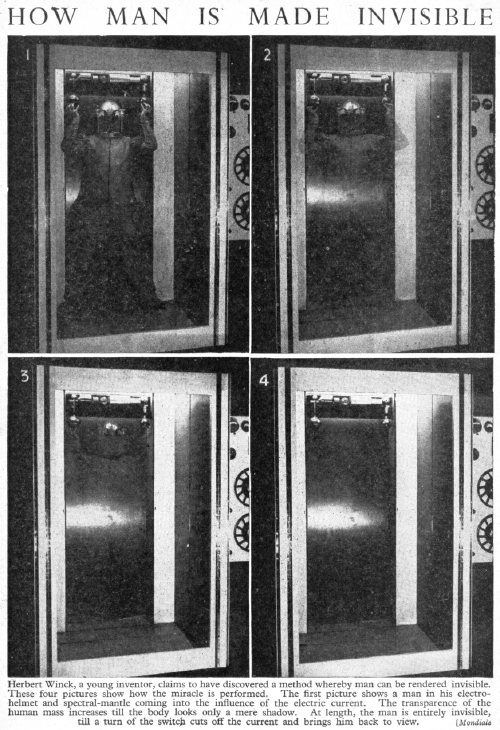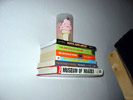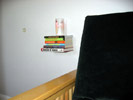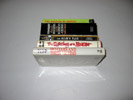MagicSHELF —
Status: It's a kind of magic trick (though it really will hold up your books)

Linkydinky.com is offering a product called the
magicSHELF. Kathy Johnston emailed me to ask: "Is this for real? I can't tell how it works." Unfortunately, I don't yet have a definitive answer. The magicSHELF has stumped me.
Pictures of the magicSHELF show books floating against a wall as if by magic, with no visible means of support. As the site says, "magicSHELF floats your books in the air, docking to any wall you wish." When I first saw it I figured it had to be a joke. This is linkydinky, after all, the creators of the infamous
Lovenstein Institute email. Plus, the pictures of the magicSHELF in action could easily have been photoshopped, and statements such as "How does magicSHELF work? It works like magic!" seem tongue-in-cheek. But then I noticed that they're taking money for these things, which put a dent in my skepticism. After all, if you send them $18, you better get something in return... and not just an empty box. I don't think linkydinky would invite people to send them money for a nonexistent product. So now I'm thinking that the magicSHELF must be real, although I have no explanation for how it works.
Update: Greg Cason ordered a magicSHELF and emailed me the flyer that explains how it works. So what's the secret? Well, now that I know, I think I need to invoke the magician's creed (don't spoil the trick) and stay mum. However, I will say that it is real, and it definitely does work.
Update 2: I received my very own magicshelf in the mail, sent by Uncle Url of linkydinky to help me verify that it is, indeed, real. Perhaps it was just a trick of the light, but I could swear that the package it arrived in was floating, ever so slightly, off the ground. 😉
Anyway, it didn't take me long to get it installed. Maybe ten minutes total. You can see the results below.
When you get the magicSHELF your first thought might be, "This is so simple. Why didn't I think of this?" But, speaking for myself, I had never thought of it before, so I've got to give Uncle Url credit for the idea. And it definitely looks cool to have books magically floating on the wall. It's a surreal effect. You kind of have to blink twice to make sure your eyes aren't playing tricks on you. It really looks like there should be something supporting the books. Great conversation starter. I know I'm going to be showing it off to every guest that comes over.
So how sturdy is it? Well, I wouldn't stack a lot of books on it. Six or seven seems about right. Also, I wouldn't lean on it or let kids hang on it (unless you want a hole in your wall). But if it's by your bedside, it'll support some books and a glass of water, no problem.
If you're handy with making stuff on your own, you could probably jerry-rig something similar to the magicSHELF for less money. (But if you can't imagine how this might be done, then you're probably not handy enough to take on such a project.) However, the challenge would be to find the right parts. When I was at Home Depot this morning, I quickly checked to see how easy it would be to find similar parts. I found a few things that could work, if I had the tools to bend them into the right shape. But I don't have those kind of tools. However, I'm pretty sure that if one were to drive around to a few different hardware stores, you could eventually find something roughly equivalent. But how much effort are you willing to expend? It's a lot easier just to order it from Uncle Url. And it is his idea, after all.
Disclaimer: I don't have any kind of financial arrangement with linkydinky, but I have agreed to let Uncle Url quote me as saying that the magicSHELF is real. In return, whenever he uses my testimonial, he mentions that I have a book coming out soon,
Hippo Eats Dwarf. So I do derive some benefit from that.


 A lot of sites have been linking to this video of a pair of quick-change artists performing on NBC's America's Got Talent. The video is fun to watch if you haven't seen them performing before. The pair are magicians David & Dania, who were recently profiled in this Slate.com article. Apparently the duo have become the most popular act during NBA half-time shows.
A lot of sites have been linking to this video of a pair of quick-change artists performing on NBC's America's Got Talent. The video is fun to watch if you haven't seen them performing before. The pair are magicians David & Dania, who were recently profiled in this Slate.com article. Apparently the duo have become the most popular act during NBA half-time shows.  On YouTube there's a video of magician Criss Angel taking the old "sawing a woman in half" trick a step further. He actually pulls a woman in half, whereupon her upper half crawls away in horror while her legs remain behind wriggling. I, like many other people, have been trying to figure out how he does this trick. All I can conclude is that it's achieved by clever editing of the camera footage. (Which, if true, would make it less a magic trick than a special effect, but entertaining nonetheless.) My reasoning is that the (half of a) woman who crawls away at the end is probably not fake. She's likely a woman who, in real life, has no legs. But this cannot be the same woman who initially walks to the table and lies down on it. (No, I don't think she was using robotic legs, or anything like that.) They are two different women. Which means that at some point the camera must have been turned off, and the one woman replaced the other on the table. This also suggests that everyone in the crowd were actors. That's my theory. But I'm actually hoping it's wrong, because it would be cool if he could have done this without turning the camera off at some point. (Thanks to Captain DaFt for the link.) (And I could have sworn I once posted about another Criss Angel trick in which he crawled through a glass window pane, but for the life of me I can't find the post about this.)
On YouTube there's a video of magician Criss Angel taking the old "sawing a woman in half" trick a step further. He actually pulls a woman in half, whereupon her upper half crawls away in horror while her legs remain behind wriggling. I, like many other people, have been trying to figure out how he does this trick. All I can conclude is that it's achieved by clever editing of the camera footage. (Which, if true, would make it less a magic trick than a special effect, but entertaining nonetheless.) My reasoning is that the (half of a) woman who crawls away at the end is probably not fake. She's likely a woman who, in real life, has no legs. But this cannot be the same woman who initially walks to the table and lies down on it. (No, I don't think she was using robotic legs, or anything like that.) They are two different women. Which means that at some point the camera must have been turned off, and the one woman replaced the other on the table. This also suggests that everyone in the crowd were actors. That's my theory. But I'm actually hoping it's wrong, because it would be cool if he could have done this without turning the camera off at some point. (Thanks to Captain DaFt for the link.) (And I could have sworn I once posted about another Criss Angel trick in which he crawled through a glass window pane, but for the life of me I can't find the post about this.) Stevie Starr calls himself a professional regurgitator. He's been doing his act for a long time, and is quite famous. (He's appeared on shows such as Jay Leno and Ripley's Believe it or Not.) But I just became aware of him through a video of one of his performances on Google Video, and I'm at a complete loss to explain how he does what he does.
Stevie Starr calls himself a professional regurgitator. He's been doing his act for a long time, and is quite famous. (He's appeared on shows such as Jay Leno and Ripley's Believe it or Not.) But I just became aware of him through a video of one of his performances on Google Video, and I'm at a complete loss to explain how he does what he does.  Linkydinky.com is offering a product called the magicSHELF. Kathy Johnston emailed me to ask: "Is this for real? I can't tell how it works." Unfortunately, I don't yet have a definitive answer. The magicSHELF has stumped me.
Linkydinky.com is offering a product called the magicSHELF. Kathy Johnston emailed me to ask: "Is this for real? I can't tell how it works." Unfortunately, I don't yet have a definitive answer. The magicSHELF has stumped me. 

